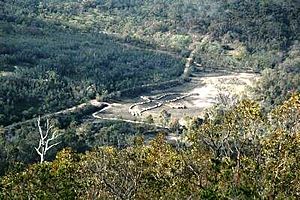Geoglyph facts for kids
A geoglyph is a huge design or picture made on the ground. These designs are usually bigger than 4 meters (about 13 feet) long. They are often made from natural materials like stones, gravel, or even by shaping the earth itself.
There are two main types of geoglyphs. A positive geoglyph is made by placing rocks or other materials on the ground to form a shape. Think of it like drawing with stones. A negative geoglyph is made by removing the top layer of soil or rocks to show a different color of ground underneath. This is like scratching a picture into a surface.
Ancient Ground Art
The most famous geoglyphs are the Nazca Lines in Peru. These amazing designs were made by ancient people. We are not entirely sure why they created them. Many ideas exist, but their true meaning is still a mystery.
In the Arabian Peninsula, there are also many old stone structures. Some people call these geoglyphs. However, recent studies show they were built for different reasons. They might have been burial sites or places to trap animals. Some were also cleared areas for camps or homes.
Since the 1970s, many geoglyphs have been found in the Amazon rainforest in Brazil. These were discovered after parts of the forest were cleared. Their discovery suggests that ancient civilizations lived in the Amazon long ago. Ondemar Dias first found these geoglyphs in 1977. Alceu Ranzi helped find even more by flying over the Acre region.
Other places with ancient ground art include Kazakhstan and parts of the Great Basin Desert in the United States. In the UK, you can find large figures cut into chalk hillsides. Famous examples include the Uffington White Horse and the Cerne Abbas Giant. These are also types of geoglyphs.
Modern Ground Art
Not all geoglyphs are ancient. Many new ones have been created by artists. This is part of a movement called Land Art. One famous example is Spiral Jetty by Robert Smithson.
Many towns in the Western United States have "hillside letters." These are huge letters made on hills above the towns. They often show the first letter of the town's name.
The modern artist Andrew Rogers has made geoglyphs all over the world. His artworks are called "The Rhythms of Life." In Australia, he created a geoglyph of Bunjil. Bunjil is a mythical creature important to the local Aboriginal people. This artwork is located in You Yangs National Park. It is 100 meters (328 feet) wide and used 1,500 tonnes of rock.
In Central and Inner Asia, you can find geoglyphic texts and images. People have also used mobile apps like Strava to create "virtual geoglyphs." These are paths they walk or run that form a picture when viewed on a map.
Images for kids
-
The Litlington White Horse in the village of Litlington, England.
See also
 In Spanish: Geoglifo para niños
In Spanish: Geoglifo para niños







